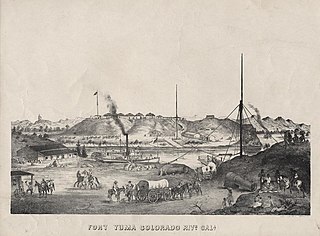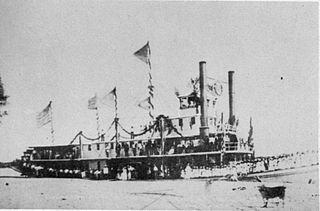Robinson's Landing was a location in Baja California, Mexico. It lay on the west bank of the Colorado River northwest of the north tip of Montague Island in the Colorado River Delta, 10 miles above the mouth of the river on the Gulf of California. Named for David C. Robinson, it was the place where cargo was unloaded in the river from seagoing craft on to flatbottomed steamboats and carried up to Fort Yuma and points further north on the river from 1852 onward. Joseph C. Ives, described it as it was in 1858, in his 1861 Report upon the Colorado river of the West The river here was subject to a severe tidal bore that formed in the estuary about Montague Island and propagated upstream and could on occasion swamp barges, boats and ships. By 1865, a better location was found, ships offloaded their cargos on the east bank of the river at Port Isabel, Sonora, northeast of Montague Island. 17 miles from Robinson's landing and 57 miles below Port Famine.

El Dorado Canyon is a canyon in southern Clark County, Nevada famed for its rich silver and gold mines. The canyon was named in 1857 by steamboat entrepreneur Captain George Alonzo Johnson when gold and silver was discovered here. It drains into the Colorado River at the former site of Nelson's Landing.

Steamboats on the Colorado River operated from the river mouth at the Colorado River Delta on the Gulf of California in Mexico, up to the Virgin River on the Lower Colorado River Valley in the Southwestern United States from 1852 until 1909, when the construction of the Laguna Dam was completed. The shallow draft paddle steamers were found to be the most economical way to ship goods between the Pacific Ocean ports and settlements and mines along the lower river, putting in at landings in Sonora state, Baja California Territory, California state, Arizona Territory, New Mexico Territory, and Nevada state. They remained the primary means of transportation of freight until the advent of the more economical railroads began cutting away at their business from 1878 when the first line entered Arizona Territory.
Lerdo Landing, now a ghost town, in Baja California was originally located in Sonora, Mexico from 1872 to 1896. Later changes to the course of the Colorado River and political boundaries left the site located in Baja California.
Explorer was a small, custom-made stern-wheel steamboat built for Second lieutenant Joseph Christmas Ives and used by him to carry the U. S. Army Corps of Topographical Engineers expedition to explore the Colorado River above Fort Yuma in 1858.
Cocopah, was a stern-wheel paddle-steamer, the fifth steamboat on the Colorado River, first put on the river in August 1859.

Cocopah II, was a stern-wheel paddle-steamer, the tenth steamboat on the Colorado River, first put on the river in 1867.
The Union Line was a transport company of steamboats of the Colorado River, owned by Thomas E. Trueworthy, operating in southeastern California, western Arizona Territory, and northwestern Mexico.

John Gunder North was a Norwegian born ship builder in San Francisco. During his career, he built 273 hulls of all kinds with 53 bay and river steamers, including the famed paddle steamers Chrysopolis, Yosemite and Capital.
Esmerelda, was a stern-wheel paddle-steamer, built for the Sacramento River trade, in 1864 it became the first of the opposition steamboats on the Colorado River. It was also the first steamboat to tow large cargo barges on that river, in May 1864 and to reach Callville, Nevada in 1866.
Mohave was the first stern-wheel steamboat of that name running on the Colorado River between 1864 and 1875.
Nina Tilden, one of the two opposition stern-wheel steamboats that ran on the Colorado River from 1864 to 1868. Purchased by George A. Johnson Company it ran on the Colorado River from 1868 until 1874.
Williamsport is a former mining town and present day ghost town, on the bank of the Colorado River in La Paz County, Arizona.
Gila, a stern-wheel steamboat of the Colorado Steam Navigation Company running on the Colorado River between 1873 and 1899.
Alfred Henry Wilcox (1823-1883), sea captain, later Colorado River pioneer and steamboat and steamship entrepreneur, partner in the George A. Johnson & Company and of the Colorado Steam Navigation Company, banker and director of the California & Mexican Steam Ship Line.
Hualapai Smith's or Smith's Ferry was a steamboat landing and a ferry crossing and farm on the Sonora bank of the Colorado River, the border between Sonora and Baja California, from the later 1860s to 1878. It was located on the Colorado River in Sonora 20 miles overland from Yuma, Arizona and 30 miles down river from Fort Yuma in 1861.
Olive City, or Olivia, was a short-lived town, steamboat landing, and ferry crossing on the Colorado River in what was then Yuma County, Arizona Territory, from 1863 to 1866. It was located on the Arizona bank of the Colorado River, 1 mile above its rival Mineral City and 1/2 mile above the original site of Ehrenberg, Arizona, 3 miles southwest of the location of La Paz. The GNIS location of Olive City (historical) is indicated as being in La Paz County, Arizona, but its coordinates in the present-day now put it across the river just within Riverside County, California. Olive City was named after Olive Oatman who had been, with her sister, survivors of the massacre of her family and a captive of the Yavapai until purchased from them by the Mohave who they lived with for several years.
George A. Johnson & Company was a partnership between three men who pioneered navigation on the Colorado River. Benjamin M. Hartshorne, George Alonzo Johnson and Alfred H. Wilcox. The George A. Johnson & Company was formed in the fall of 1852, and was reorganized as the Colorado Steam Navigation Company in 1869.

Mohave, the second stern-wheel steamboat of that name running on the Colorado River for the Colorado Steam Navigation Company (C.S.N.C) between 1875 and 1876. It was the first and only double smokestack steamboat to run on the river.
Port Isabel Slough was a deep slough in the Colorado River Delta near the mouth of the Colorado River during the 19th century, within the state of Sonora, Mexico.






